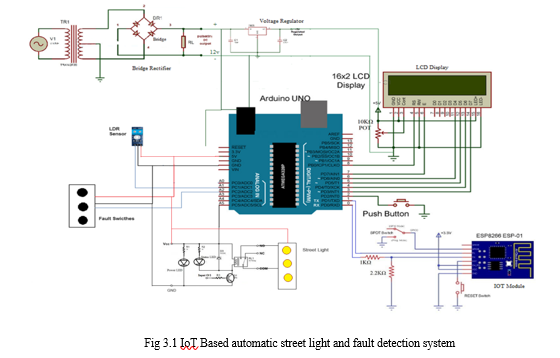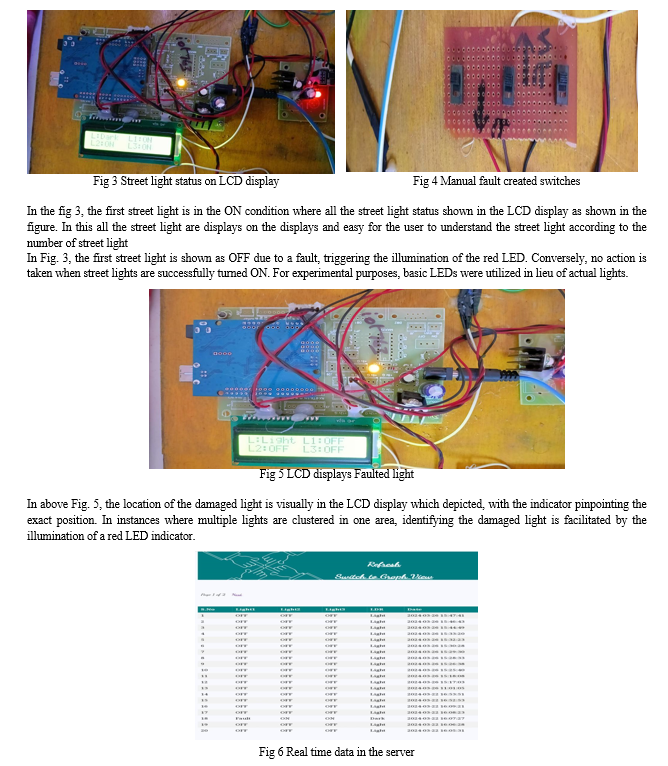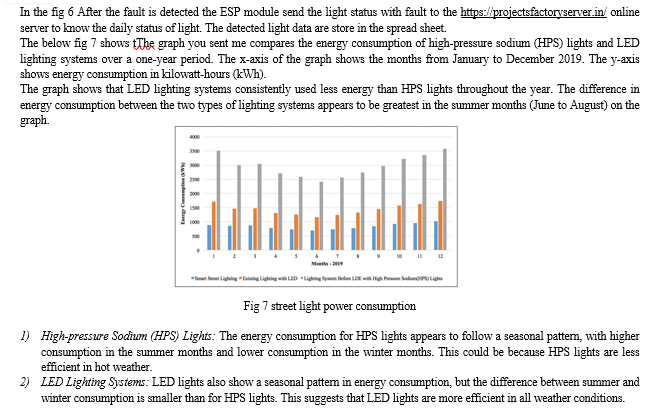Ijraset Journal For Research in Applied Science and Engineering Technology
- Home / Ijraset
- On This Page
- Abstract
- Introduction
- Conclusion
- References
- Copyright
Implementation of Arduino Based System for Automatic Street Light Switching and Fault Detection
Authors: Prof. S. A. Bagal, Mohd. Tanvir Sheikh, Gunjan Makde, Deepak Molguri
DOI Link: https://doi.org/10.22214/ijraset.2024.59509
Certificate: View Certificate
Abstract
The imperative for deploying automated street lighting systems in India is underscored by the significant opportunity to enhance energy efficiency a pivotal goal for a country committed to optimizing energy use. Research indicates that transitioning to LED street lighting can lead to a 30% decrease in energy consumption, translating into a substantial electricity conservation of approximately 2,326 GWh. LED technology is renowned for its potential to reduce energy requirements by up to 80% in comparison to conventional lighting methods, offering a more sustainable alternative that significantly lowers electricity demand. Transitioning to energy-efficient lighting plays a vital role not only in diminishing energy use but also in contributing to environmental protection by reducing CO2 emissions. Furthermore, the incorporation of automated control mechanisms in street lighting systems, such as daylight sensors and solar panels, which adjust lighting based on sunlight exposure, further boosts energy efficiency. These adaptive systems modulate lighting intensity according to the ambient environment and detected movements, such as the presence of vehicles, thereby ensuring judicious use of power and minimizing wastage. The extended lifespan of LED bulbs, capable of lasting up to 50,000 hours, further contributes to cost savings and lessens the frequency of replacements, supporting continuous environmental conservation efforts. Thus, the embrace of automated and energy-efficient street lighting in India signifies an essential stride towards realizing energy savings, economic benefits, environmental preservation, and enhanced urban safety. This movement towards innovative and environmentally friendly lighting technologies denotes India\'s progress towards a brighter, more sustainable future.
Introduction
I. INTRODUCTION
The evolution of street lighting in India represents a significant stride towards augmenting energy efficiency and championing ecological conservation. Initiated in 2001, the journey towards improving urban illumination has seen considerable advancements. Initially dominated by High-Pressure Sodium (HPS) lamps, these sources, despite their widespread use, faced criticism for their role in exacerbating light pollution and generating significant glare, highlighting the urgent need for a more sustainable and efficient lighting solution. The advent of Light-Emitting Diode (LED) technology has been a pivotal shift, introducing an option that not only conserves energy but also offers a longer lifespan than conventional alternatives.
The shift towards LED technology has transformed street lighting across India, introducing benefits such as superior light quality, higher efficiency, and greater longevity. These lights stand out for their reduced energy consumption and extended operational life, contributing significantly to the nation’s efforts in conserving energy. A key strategy in this transformation has been the retrofitting of existing streetlights with LED models, achieving the same brightness levels as HPS lamps but with considerably lower power usage.
Governmental programs like the LED Street Lighting National Programmed (SLNP) and Unnat Jyoti by Affordable LEDs for All (UJALA) have been instrumental in this shift, leading to the installation of over 10.3 million intelligent LED streetlights. These initiatives have not only enabled considerable energy savings but have also contributed to a significant reduction in CO2 emissions. By March 2020, the SLNP aimed to replace 13.4 million conventional streetlights with smart LED alternatives, targeting a reduction in peak electricity demand and securing substantial annual energy savings.
Looking forward, India is poised to integrate Internet of Things (IoT) technology to foster automated street lighting systems that boast superior fault detection capabilities. This progressive move aims to enhance operational efficiency, streamline maintenance processes, achieve cost savings, and improve safety and security. Furthermore, it supports data-informed decision-making and aligns with the overarching goal of endorsing environmental sustainability. By adopting such advanced technologies, India is setting the stage for the creation of smarter, greener urban environments that prioritize the well-being of its inhabitants and the health of the planet.
II. LITRATURE REVIEW
The examination by M. Manu Satwik, T. Prudhvi, and K. Vivek Reddy [1] delves into the integration of Internet of Things (IoT) technology within street lighting systems, employing GSM technology as a backbone. This study sheds light on the transformative potential of IoT to elevate the functionality of street lighting infrastructures. Despite its potential, the study acknowledges the challenges related to the cost, reliability, and scalability of such IoT solutions, suggesting these factors as possible hurdles in widespread adoption.
In research carried out by Sakthi Priya V. and M. Vijayan [2], the focus is on devising an automatic street light control mechanism that harnesses the capabilities of wireless sensor networks (WSN) to respond to vehicle movement and environmental conditions. The implementation, based on the Raspberry Pi platform integrated with IoT technologies, is praised for its high-performance capabilities and precision.
However, concerns regarding the high costs of deployment and the system’s sensitivity to weather conditions—which could impair its accuracy in adverse scenarios—are highlighted as primary concerns.
Lastly, the development of an Arduino-Based Smart Light Control System by Deepak Kumar Rath [5] is introduced as a straightforward, user-friendly approach utilizing Arduino technology for street lighting. While accessible, this system is critiqued for being somewhat antiquated against the backdrop of rapid technological advancements, signaling a call for updates and improvements to remain relevant.
Collectively, these studies present a diverse spectrum of strategies for integrating IoT and related technologies into street lighting automation. They highlight the sector's advancements towards enhancing energy efficiency and operational effectiveness. Nonetheless, the outlined challenges—ranging from financial constraints and system complexity to environmental sensitivities and technological obsolescence—underscore the necessity for ongoing innovation and research to address these issues in future deployments.
III. PURPOSE WORK
In the study of the Damaged Street Light Identification System, our focus lies in assessing the reduction in power consumption. In today's modern lifestyle, energy stands as a fundamental necessity for both developing and developed nations. To gain deeper insights, we have constructed a prototype for street lighting, aiming to evaluate the efficacy of our system.
Our research endeavors encompass a comprehensive review of various sources, delving into diverse concepts surrounding street light systems and the associated risks of human intervention. Within this study, we explore two pivotal concepts, yielding distinct and noteworthy outcomes. By integrating additional systems into the street lighting framework, we strive to enhance operational efficiency while minimizing power consumption and costs, all of which can be remotely accessed via the internet. The widespread adoption of LED driver architectures plays a pivotal role in designing smart street light systems, fostering reliability and curbing energy wastage.
These architectures seamlessly facilitate the automatic switching ON/OFF of lights, promoting energy efficiency. Additionally, studies conducted by Morais et al. and Silva et al. have further delved into the dimming mechanisms of lights, as per the guidelines set forth by IEEE.
At the 2017 R10-HTC conference in Dhaka, Bangladesh, significant energy savings were achieved by implementing a system that controls street light ON/OFF based on object movement, using IR modules. Similarly, our project utilizes LDRs to detect light conditions, GPS for precise location fetching, and LEDs to indicate damaged lights. Data from the Bluetooth module is parsed for latitude and longitude, facilitating location access. Each street light is equipped with an LDR and red LED for fault indication. Relays connect the lights, with power loss or damage detected through threshold values. Continuous monitoring via cloud storage ensures real-time system oversight, facilitated by internet connectivity. The IoT concept integrates sensors, software, cloud, and hardware for effective system operation, aligning with the smart city development initiative.
IV. CIRCUIT DIAGRAM

V. SYSTEM DESIGN
- Designing an IoT-enabled environment to facilitate real-time control of streetlights and assessing the application's performance through testing.
- Utilizing ambient light sensors to experimentally measure light intensity and adjust streetlight control actions accordingly.
- Constructing a library of diverse modules to replicate the conditional parameters of the network for comprehensive testing and evaluation.
When compared to the Automatic Street light system, this research work offers several advantages. It achieves energy savings ranging from 8 to 10 percent by operating based on sunrise and sunset timings, while also adapting to weather conditions, particularly during winter. Additionally, it streamlines maintenance efforts by swiftly identifying damaged lights and sending automated alert messages to authorized personnel. These messages include details of the light malfunction and a URL indicating its exact location, thereby reducing the need for manual reporting. Users can access the location information by selecting the provided URL. Moreover, the system continually monitors all locations through cloud-based infrastructure, ensuring comprehensive oversight and efficiency.
A. Flow Chart
A flowchart is a graphical representation of a process or algorithm, typically used in computer programming, engineering, and various other fields to visually illustrate the steps involved in completing a task or solving a problem. Flowcharts use standardized symbols and shapes to represent different actions, decisions, inputs, and outputs within the process. Flowcharts provide a visual representation of the sequential steps and decision points within a process, making it easier to understand, analyze, and communicate complex procedures. They are commonly used for process documentation, troubleshooting, algorithm design, and project planning.

Fig. 2 illustrates the system's entire workflow. Initially, the Light Dependent Resistor (LDR) assesses the ambient light status, determining if it is ON or OFF. If the light is already ON, no further action is taken. However, if the ambient light is OFF, the street lights automatically switch ON. In case of any malfunction in the street lamps, individual red LEDs attached to each street light illuminate. The red LED indicates the presence of a fault, with the color red symbolizing damage.
Each street light is equipped with its own Light Dependent Resistor (LDR) and red LED, serving to autonomously detect and signal a faulty lamp. Upon detection, the system promptly relays the precise location to the designated recipient via the thinkspeak cloud storage platform. This entails transmitting a predefined message along with the authorized person's mobile number. Leveraging Bluetooth technology, our project utilizes Bluetooth module data to accurately pinpoint the location of the malfunctioning light. Following the repair of the damaged lamp, the red LED deactivates automatically, ensuring efficient maintenance operations.
This flowchart outlines the operation of a system designed to control a lamp's intensity based on readings from an IR sensor (presumably an Infrared sensor) and an LDR sensor (Light Dependent Resistor), while also sending notifications to a mobile device.
- Loading the IR Sensor: The system initiates by loading the IR sensor, indicating the start of its operation.
- Checking IR Sensor Value: The flowchart checks the value obtained from the IR sensor.
- Low Intensity Lamp Setting: If the IR sensor value is less than 11, the system determines that the ambient light level is low. In this case, it checks the value of the LDR sensor. If the LDR sensor value is less than 50, indicating low light intensity, the system sets the lamp to glow at a low intensity. Additionally, it sends a message to the mobile device indicating that everything is functioning correctly.
- High Intensity Lamp Setting: If the IR sensor value is greater than or equal to 11, indicating sufficient ambient light, but the LDR sensor value is not low (less than 50), the system sets the lamp to glow at high intensity. Again, it sends a message to the mobile device confirming normal operation.
- Fault Detection: If the LDR sensor value is 4000 or greater, suggesting a very high ambient light level, the system determines that the lamp should not glow, indicating a fault in the light. It then sends a message to the mobile device alerting the user of the fault.
- Default Setting: If none of the above conditions are met, the system defaults to setting the lamp to glow at high intensity.
In summary, this flowchart describes a system that automatically adjusts a lamp's intensity based on readings from light sensors. It ensures efficient energy use by dimming or brightening the lamp according to ambient light conditions. Additionally, it provides real-time notifications to a mobile device, alerting the user to any faults detected in the lamp.
VI. EXPERIMENTAL SETUP
The proposed framework utilizes Arduino technology for the automation and supervision of street lighting, with a focus on efficient management and rapid fault detection.
This system leverages the Internet of Things (IoT) to connect street light operations to the cloud, allowing for remote monitoring and control based on light intensity data. This approach is both cost-effective and demands minimal maintenance compared to alternative solutions.
A. Key Components
- Arduino UNO: A widely recognized open-source microcontroller, ideal for beginners and hobbyists interested in exploring the realms of electronics and programming. Its features include multiple digital and analog input/output pins, a USB connection, and a power jack, making it versatile for various electronics projects.
- Light Dependent Resistor (LDR) Sensor: A sensor that adjusts its resistance in response to light intensity, crucial for automatic adjustment of street light brightness.
- Liquid Crystal Display (LCD): A display technology used to show real-time system statuses and diagnostics.
- IoT Module: Facilitates wireless connectivity, enabling the system to send and receive data over the internet for remote monitoring and control.
- Relay Board: Acts as an intermediary to control high-power street lights using the Arduino's low-power output.
- Street Light Poles: The physical structure supporting the lighting fixtures, integral to illuminating public spaces.
- Fault Creation Switches: Simulate various electrical faults for system testing and troubleshooting.
- Power Supply: Converts AC to DC power, supplying the necessary electricity to run the system components.
B. Advantages
- Flexibility: The system is highly adaptable, allowing for customization to meet specific lighting needs or to incorporate additional monitoring sensors.
- Affordability: Arduino components are cost-effective, making this system a financially viable option for large-scale deployment in public lighting infrastructures.
- Rapid Development: The Arduino IDE simplifies coding, enabling quick prototyping and modifications, which accelerates the implementation process.
- Peripheral Integration: Supports the incorporation of various sensors and modules, enhancing the system's capabilities beyond basic lighting control, such as environmental monitoring and advanced fault detection.
- Energy Efficiency: Designed for low power consumption, the system contributes to energy savings and sustainability objectives.
C. Considerations
- System Reliability: The durability and reliability of Arduino components in commercial or industrial settings, particularly in extreme weather conditions, may not match those of specialized hardware.
- Scalability Challenges: While expandable, the system might encounter limitations when scaling to manage vast networks of street lights, necessitating careful planning for large-scale deployments.
VII. RESULT
Initially, a prototype was designed to outline the system's arrangement process, laying the groundwork for future research and development. Following the completion of the entire project, a proposed system, as depicted in Fig. 3, was developed and rigorously tested over several months to validate its real-time functionality. Our methodology significantly enhanced fault detection accuracy while efficiently managing street light ON/OFF cycles, resulting in substantial electricity savings.


Conclusion
By integrating Light Dependent Resistor (LDR) sensors, these intelligent street lights adjust their brightness according to ambient light levels, ensuring optimal illumination while minimizing energy consumption. This not only reduces electricity expenses but also supports sustainability endeavors by decreasing overall energy usage. Moreover, the incorporation of Internet of Things (IoT) technology facilitates remote monitoring and control of the street lights, empowering authorities to efficiently manage and upkeep the lighting infrastructure. Real-time data collection and analysis offer valuable insights into usage patterns, enabling predictive maintenance and targeted interventions to address issues promptly. Furthermore, IoT connectivity enables seamless communication among street lights, establishing a network capable of responding intelligently to changing conditions. For instance, lights can adjust brightness in response to pedestrian or vehicular traffic, enhancing safety and convenience for residents and commuters. In summary, deploying smart street lights utilizing LDR sensors and IoT technology represents a significant advancement in urban infrastructure modernization. By harnessing these innovations, cities can achieve enhanced energy efficiency, cost savings, and overall sustainability, while providing safer and more comfortable environments for their residents.
References
[1] SMART STREET LIGHT SYSTEM BASED ON ARDUINO introduced by Kavita Jain*1, Mudit Surana*2, Prince Meena*3, Pushpendra Meena*4, Rahul Meena*5, *1Assistant Professor, Department of Electrical Engineering, SKIT, Jaipur, Rajasthan, India. *2,3,4,5UG Scholar, Department of Electrical Engineering, SKIT, Jaipur, Rajasthan, India. Publish in e-ISSN: 2582- 5208 International Research Journal of Modernization in Engineering Technology and Science (Peer-Reviewed, Open Access, Fully Refereed International Journal) Volume:04/Issue:05/May-2022 [2] Automatic Street Light Control System, Miss. Komal Jadhav1, Miss. Apeksha More2, Miss. Shraddha Rakshe3, Miss. Payal Shinde4, Prof. Arya C. S.5 Student, BE Computer, JCOE, Department of Computer Engineering, Kuran1 2 3 4 Assistant Professor, JCOE, Department of Computer Engineering, Kuran5. publish || Volume 3 || Issue 5 || May 2018 || ISSN (Online) 2456-0774 INTERNATIONAL JOURNAL OF ADVANCE SCIENTIFIC RESEARCH AND ENGINEERING TRENDS [3] Arduino Based: Smart Light Control System Deepak Kumar Rath Undergraduate Student, Instrumentation & Electronics Engineering College of Engineering and Technology, Bhubaneswar International Journal of Engineering Research and General Science Volume 4, Issue 2, March- April, 2016 ISSN 2091-2730 [4] Automatic control system of highway lights Yasir Hashim1, Mohammed Nazmus Shakib2 1Department of Computer Engineering, Faculty of Engineering, Tishk International University, Iraq 2Faculty of Electrical and Electronic Engineering Technology, University Malaysia Pahang, Malaysia [5] IOT based Automatic Street Light Control and Fault Detection Prashant Kumar 1, Shivaraj S Hiremath2, G V Sandeep 3, Santosh Kumar Javalagi4, Dr. Venkata Siva Reddy5 1Departmentof Electronics and Communication and Engineering, REVA University Bengaluru, (India). [6] A.A.Nippun Kumaar, Kiran.G, Sudarshan TSB,” Intelligent Lighting System Using Wireless Sensor Networks”, International Journal of Ad hoc, Sensor & Ubiquitous Computing (IJASUC) Vol.1, No.4, December 2010, pp 17-27 [7] Y. K. Tan; T. P. Huynh; Z. Wang,” Smart Personal Sensor Network Control for Energy Saving in DC Grid Powered LED Lighting System”, IEEE Trans. Smart Grid [8] O’Reilly, Fergus, and Joe Buckley. \"Use of wireless sensor networks for fluorescent lighting control with daylight substitution.\" Proceedings of the Workshop on Real-World Wireless Sensor Networks (REANWSN). 2005. [9] Divya, Guddeti, et al. \"Design and Implement of Wireless Sensor Street Light Control and Monitoring Strategy along with GUI.\" IJITR (2016): 78-81. [10] Fitch, Andrew Lewis, et al. \"Realization of an analog model of memristor based on light dependent resistor.\" Circuits and Systems (ISCAS), 2012 IEEE International Symposium on. IEEE, 2012. [11] Tran, Duong, and Yen Kheng Tan. \"Sensor less illumination control of a networked LED-lighting system using feedforward neural network.\" Industrial Electronics, IEEE Transactions on 61.4 (2014): 2113-2121. [12] Kim, Sangil, et al. \"Design of lighting Fluorescent lamp and AC LED control board using MCU.\" Journal of the Korean Institute of Power Electronics (2010): 252-253. [13] Song, Sang-bin, Woo-young Cheon, and Young-?. Yu. \"Design of a LED lighting bar replacement neon sign.\" Journal of the Korean Institute of Electrical Engineers (2006): 1671-1672. [14] Tran, Duong, and Yen Kheng Tan. \"Sensor less illumination control of a networked LED-lighting system using feed forward neural network.\" Industrial Electronics, IEEE Transactions on 61.4 (2014): 2113-2121.
Copyright
Copyright © 2024 Prof. S. A. Bagal, Mohd. Tanvir Sheikh, Gunjan Makde, Deepak Molguri. This is an open access article distributed under the Creative Commons Attribution License, which permits unrestricted use, distribution, and reproduction in any medium, provided the original work is properly cited.

Download Paper
Paper Id : IJRASET59509
Publish Date : 2024-03-27
ISSN : 2321-9653
Publisher Name : IJRASET
DOI Link : Click Here
 Submit Paper Online
Submit Paper Online

